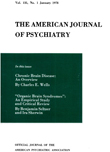A COMPARATIVE STUDY OF SELECTED ANTIDEPRESSANT MEDICATIONS AND EST
Abstract
The effectiveness of 3 antidepressant medications was compared with that of EST in 128 depressed hospitalized patients at 3 state mental hospitals. The results of this double blind study employing 4 different measures of treatment outcome present a consistent trend. They indicate that:
1. In this sample, the 4 treatments produced 50% marked improvement, 25% moderate improvement, and only 25% minimal improvement or lack of response. Although the absolute number of patients in the 3 hospitals differed, no appreciable deviation from this distribution was found in any of the 3 institutions.
2. There was no difference in treatment outcome between the 33 males and the 95 females. However, patients in the 16-39 age group showed more marked improvements than older patients. In addition, exogenous depressions responded significantly better to the 4 somatic treatments than schizo-affective and endogenous patients.
3. Patients treated with EST manifest a higher degree of improvement than patients treated with the 3 antidepressant medications. Specifically, a higher proportion of EST patients improved markedly than patients on drugs. In terms of symptom remission, decrease of depressive affect, and decrease in behavioral disturbance, EST patients in general fared better than the other patients. However, this was significant in all cases only in comparison to patients treated with isocarboxazid. Patients treated with imipramine revealed on several of the measures higher degrees of improvement than patients treated with the 2 MAO inhibitors.
4. When EST patients were compared with all drug patients to study selectivity of the 2 somatic treatments, it was found that younger patients, male patients, and patients with exogenous and schizo-affective depressions appeared to do as well on drugs as on EST. In the case of females, older patients, and endogenous depressions, EST showed significantly more marked results than the antidepressant medications.
5. The 4 measures were very consistent in revealing this pattern of results, with one exception: phenelzine appeared to show a higher degree of effectiveness as measured by the global ratings of outcome than as measured by the 3 quantitative indices. More cases will be required to account for this discrepancy. In other respects, the 3 quantitative measures showed very high intercorrelations, and were strongly related to the qualitative ratings of treatment outcome.
6. A relatively low frequency of side effects was recorded during the course of the study. These were largely of a transient nature, and not dose related.
Access content
To read the fulltext, please use one of the options below to sign in or purchase access.- Personal login
- Institutional Login
- Sign in via OpenAthens
- Register for access
-
Please login/register if you wish to pair your device and check access availability.
Not a subscriber?
PsychiatryOnline subscription options offer access to the DSM-5 library, books, journals, CME, and patient resources. This all-in-one virtual library provides psychiatrists and mental health professionals with key resources for diagnosis, treatment, research, and professional development.
Need more help? PsychiatryOnline Customer Service may be reached by emailing [email protected] or by calling 800-368-5777 (in the U.S.) or 703-907-7322 (outside the U.S.).



